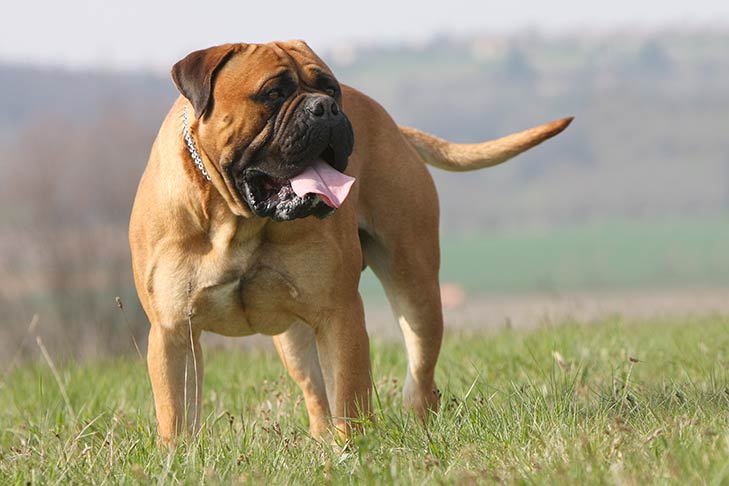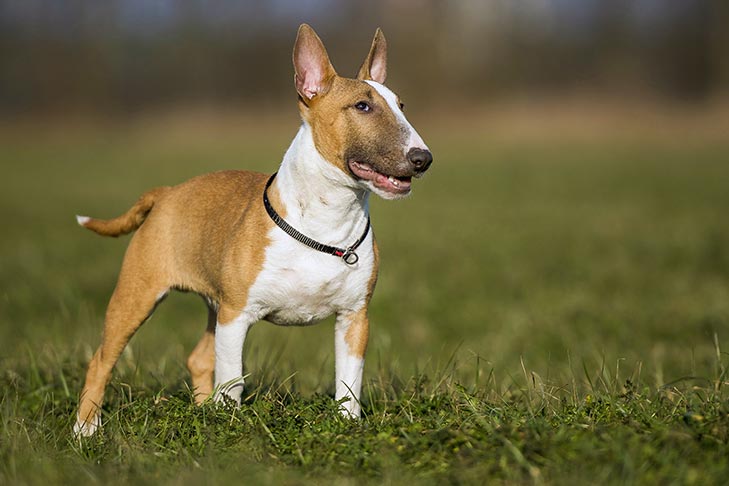
Small or large, with solidly built, wide bodies, and short coats, Bully breeds share the same characteristics as ancient molosser dogs once used to guard and protect property and livestock in Greece.
Bred for strength, some of the Bully breeds look similar. Many of them have large square heads, short muzzles, short triangular ears, and powerful jaws.
As these breeds were once used in medieval Europe for baiting bulls as a form of gambling, people referred to these breeds as “bully.” Long after the practice stopped, the nickname stuck. Although the history of these breeds includes a fighting background, these dogs today are generally affectionate, sensitive, and smart. Tenacious and loyal, they love a good game of tug at home.
The American Kennel Club recognizes the following seven Bully breeds:
American Staffordshire Terrier

A member of the Terrier Group, the American Staffordshire Terrier dates back to the early 1800s and was known in England as a Pitdog and a Pitbull Terrier. AmStaff males are typically 18 to 19 inches tall, and females are 17 to 18 inches tall when measured at the shoulder. Intelligent and good-natured, this breed thrives when given mental and physical challenges. With well-defined, strong jaws for chewing, this dog will enjoy gnawing on indestructible dog toys for hours.
The AmStaff is an enthusiastic partner and competitive in all canine performance events. At home, this dog likes plenty of attention.
Bulldog

Despite its dignified appearance, the Bulldog is more than just a pretty face. Its “sour mug” expression symbolizes courage and tenacity, which is why the Bulldog is a popular sports team mascot. This breed’s distinctive loose skin on the head, furrowed row, flat nose, and prominent jaw are universally recognized.
A member of the Non-Sporting Group, the Bulldog is friendly, easy-going, and versatile. Weighing up to 50 pounds, this breed needs regular moderate exercise, but never in hot or humid weather. The Bulldog’s very short and upturned muzzle makes breathing difficult in those conditions.
Bullmastiff

Weighing up to 130 pounds for males and 120 pounds for females, the Bullmastiff is the largest of the Bully breeds. A member of the Working Group, the Bullmastiff results from Bulldog and Mastiff breeds but is smaller than a Mastiff. Nicknamed “The Gamekeeper’s Night Dog,” the Bullmastiff guarded large English estates from poachers in the mid-to-late 19th century. It would hold an intruder rather than maul it.
At home, the breed makes a strong protector and family companion. Size aside, this breed excels at canine performance sports and is affectionate, loyal, and docile with its owner. Early training and socialization work best when Bullmastiffs are puppies. The breed can be strong-willed and will choose its own direction.
Bull Terrier

With a reputation for playing tricks on its owner and mischievous behavior, the Bull Terrier is the comedian of the Bully breeds. Loyal and entertaining, this AKC Terrier Group member oozes personality. Devoted to its owner, this unique-looking dog with its hallmark long, egg-shaped head thrives on affection.
A medium breed at 21 to 22 inches and weighing 50 to 70 pounds, there are two varieties: White and Colored, with brindle preferred in the Colored variety. In the early 1900s, Bull Terriers were crossed with brindle Staffordshire Terriers to produce the colored variety. The Bull Terrier is happiest with firm training, plenty of exercise, including canine performance sports, and time at home with its owner. Famous Bull Terriers include General George Patton’s “Willy,” “Rufus,” the 2006 Westminster Kennel Club winner, and “Bullseye,” the Target mascot.
French Bulldog

With its trademark large, erect bat ears, compact small size, and easy-going disposition, it’s easy to see why the French Bulldog is one of the most popular breeds. Nicknamed “Frenchie” for short, this charming member of AKC’s Non-Sporting Group is playful, alert, and intelligent. The breed adapts easily to life in an apartment, city living, and new pets or additional family members. As a companion, the Frenchie is affectionate to its owner and friendly with strangers but ready to sound the alarm if an intruder wanders into the home.
The French Bulldog’s acceptable colors are white, cream, fawn, and combinations. Markings and patterns include brindle, piebald, black masks, and black shadings with white markings. All other colors, markings, or patterns are unacceptable, including solid black, black and tan, blue fawn, liver, black and white, white with black, and merle.
Miniature Bull Terrier

At 10 to 14 inches tall and weighing 18 to 28 pounds, the Miniature Bull Terrier is a smaller version of the Bull Terrier but a near double of its larger cousin in every other way. Originating in England and created as a fighting dog in the 1830s with Bulldogs and the now-extinct White English Terriers, it’s a wonder how comical this breed is now. The Mini is the class clown who is full of mischief and lives for playing hijinks. This small, muscular member of AKC’s Terrier Group is strong, active, and fearless. When it comes to training, it’s best to start when the Mini is a puppy. The breed is an independent thinker who thrives on finding creative ways to work around the task.
Affectionate with its owner but protective over its household, the Miniature Bull Terrier retained its strong instinct to chase rats above the ground.
Staffordshire Bull Terrier

The Staffy Bull, as people like to call this breed today, originated in Staffordshire, England, in the 19th century. From breeding Bulldogs and smooth-coated Terriers, it had several aliases as the Bull-and-Terrier, the Patched Fighting Terrier, the Staffordshire Pit-dog, and the Brindle Bull. A reliable watchdog when called upon, this breed’s sweet nature, plus their playful and loyal personality, make them a delightful companion. When it comes to training the Staffordshire Bull Terrier, its willingness to please makes the process go smoothly. A medium and muscular breed, the Staffy Bull stands 14 to 16 inches tall and weighs between 24 and 38 pounds. This member of AKC’s Terrier Group, the Staffordshire Bull Terrier adapts to apartment and large home living.

